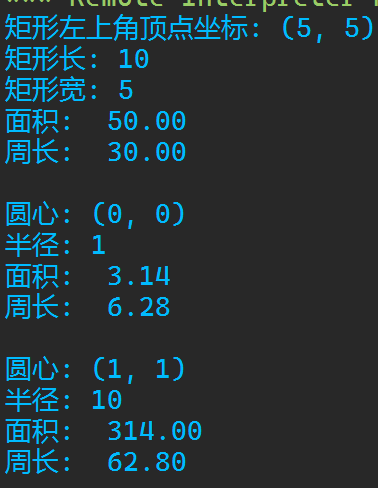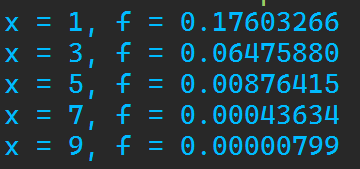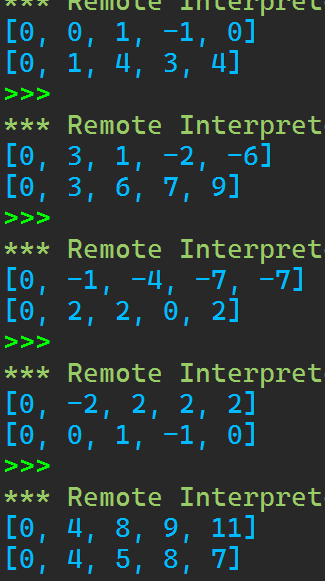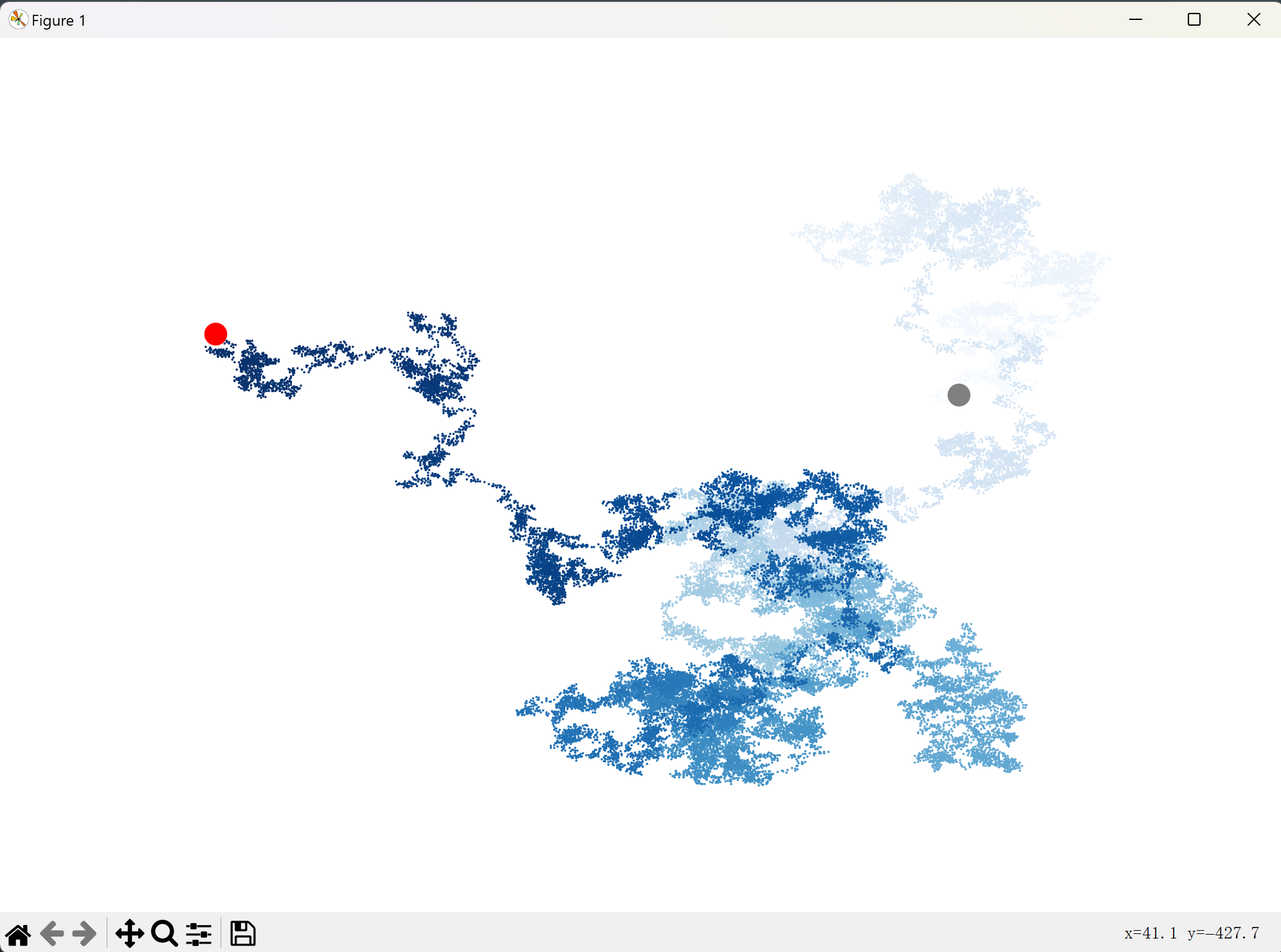实验7 面向对象编程与内置模块
一、实验结论:
1. 实验任务1:task1.py
程序源码:
1 ''' 2 银行账户 3 数据:持卡人姓名、账号、当前余额 4 操作:取款、存款、打印账户信息、返回账户余额 5 ''' 6 7 class Account: 8 '''一个模拟银行账户的简单类''' 9 10 def __init__(self, name, account_number, initial_amount = 10): 11 '''构造新账户''' 12 self._name = name 13 self._card_no = account_number 14 self._balance = initial_amount 15 16 def deposit(self, amount): 17 '''存款''' 18 self._balance += amount 19 20 def withdraw(self, amount): 21 '''取款''' 22 if self._balance < amount: 23 print('余额不足') 24 return 25 26 self._balance -= amount 27 28 def info(self): 29 '''打印账户信息''' 30 print('持卡人姓名:', self._name) 31 print('持卡人账号:', self._card_no) 32 print('持卡人账户余额:', self._balance) 33 34 def get_balance(self): 35 '''返回账户余额''' 36 return self._balance 37 38 def main(): 39 '''创建Account类对象,测试类''' 40 print('测试账户1:'.center(30, '*')) 41 a1 = Account('Bob', '5002311', 20000) 42 a1.deposit(5000) 43 a1.withdraw(4000) 44 a1.info() 45 46 print() 47 48 print('测试账户2:'.center(30, '*')) 49 a2 = Account('Joe', '5006692', 20000) 50 a2.withdraw(10000) 51 a2.withdraw(5000) 52 a2.info() 53 54 55 if __name__ == '__main__': 56 main()
运行结果截图:

问题1:面向对象中类、对象、属性、方法、实例化的概念。
类:具有相同特性(数据元素)和行为(功能)的对象的抽象就是类。
对象:对象是人们要进行研究的任何事物,它不仅能表示具体的事物,还能表示抽象的规则、计划或事件。
方法:一种编程范式,它将程序中的数据和操作封装在一起,形成对象。
实例化:在面向对象的编程中,把用类创建对象的过程称为实例化。
问题2: 你对类的封装性的理解。
封装就是把抽象的数据(属性)和对数据的操作(方法)封装在一起,数据被保护在内部程序的其他部分只有通过被授权的操作,才能对数据进行操作。
2.实验任务2:task2.py
程序源码:
程序源码:
1 from shape import Rect, Circle 2 shape_lst = [Rect(5, 5, 10, 5), Circle(), Circle(1, 1, 10)] 3 4 for i in shape_lst: 5 i.info() 6 print(f'面积: {i.area(): .2f}') 7 print(f'周长: {i.perimeter(): .2f}') 8 print()
运行结果截图:

问题1:你对类的继承、多态特性的理解。
继承性:一个类获取现有类的所有属性和行为的机制,创建基于现有类的新类,可以重用现有类的属性和方法,可以在新创建的子类中添加新属性和方法。
多态性:同一个引用类型,使用不同的实例而执行不同操作,同一种操作,由于条件不同,产生的结果也不同。
问题2:你对python中模块的理解:什么是模块。
一个模块就是包含了python定义和声明的文件。
3.实验任务3:task3.py
1 from math import pi,exp 2 3 def func(x): 4 m=0 5 s=2 6 f=(exp(-0.5*((x-m)/s)**2))/(s*(2*pi)**0.5) 7 return f 8 9 x=[1,3,5,7,9] 10 for i in x: 11 f=func(i) 12 print(f'x = {i}, f = {f:.8f}')
运行结果截图:

4.实验任务4*:模拟简单二维随机漫步
random_walk.py
程序源码:
1 ''' 2 random_walk.py是一个模块 3 封装了一个简易版的二维随机游走类 4 ''' 5 6 from random import choice 7 8 class RandomWalk(): 9 '''一个生成随机漫步数据的类''' 10 11 def __init__(self, num_points = 5000): 12 '''初始化随机漫步的属性''' 13 self.num_points = num_points 14 15 # 所有的随机漫步都始于(0,0) 16 self.x_values = [0] 17 self.y_values = [0] 18 19 20 def fill_walk(self): 21 '''计算随机漫步包含的所有点''' 22 23 # 不断漫步,直到列表到达指定长度 24 while len(self.x_values) < self.num_points: 25 # 决定前进方向,以及,沿这个方向前进的距离 26 x_direction = choice([1, -1]) 27 x_distance = choice([0, 1, 2, 3, 4]) 28 x_step = x_direction * x_distance 29 30 y_direction = choice([1, -1]) 31 y_distance = choice([0, 1, 2, 3, 4]) 32 y_step = y_direction * y_distance 33 34 # 据绝原地踏步 35 if x_step == 0 and y_step == 0: 36 continue 37 38 # 计算下一个点的x和y值 39 next_x = self.x_values[-1] + x_step 40 next_y = self.y_values[-1] + y_step 41 42 self.x_values.append(next_x) 43 self.y_values.append(next_y) 44 45 46 def main(): 47 '''测试随机游走类''' 48 49 rw = RandomWalk(5) 50 rw.fill_walk() 51 print(rw.x_values) 52 print(rw.y_values) 53 54 55 if __name__ == '__main__': 56 main()
运行结果截图:

task4.py
程序源码:
1 ''' 2 模拟多次随机漫步 3 ''' 4 5 from matplotlib import pyplot as plt 6 from random_walk import RandomWalk 7 from time import sleep 8 9 10 # 代码范例中,模拟两次随机漫步过程 11 n = 0 12 while n < 2: 13 n += 1 14 15 # 创建一个RandomWalk对象,调用其方法生成随机游走坐标 16 rw = RandomWalk(50000) 17 rw.fill_walk() 18 19 # 用散点图进行可视化绘制 20 plt.figure(figsize = (10, 6), dpi = 128) 21 point_numbers = list(range(rw.num_points)) 22 plt.scatter(rw.x_values, rw.y_values, c=point_numbers,cmap=plt.cm.Blues, 23 edgecolor='none', s=1) 24 25 # 终点和起点 26 plt.scatter(0,0,c = 'grey',edgecolors='none',s=100) 27 plt.scatter(rw.x_values[-1], rw.y_values[-1], c = 'red',edgecolors='none', 28 s=100) 29 30 # 隐藏坐标轴 31 plt.axis('off') 32 33 plt.show()
运行结果截图:

二、实验总结:
1. 熟悉Python中面向对象编程的概念(类、对象、属性、方法)、特性(封装、继承、多态)、基础语法
2. 了解Python中模块、包的概念和常用操作
3. 练习使用常用内置模块的常用方法:math, random, datetime, string






 浙公网安备 33010602011771号
浙公网安备 33010602011771号